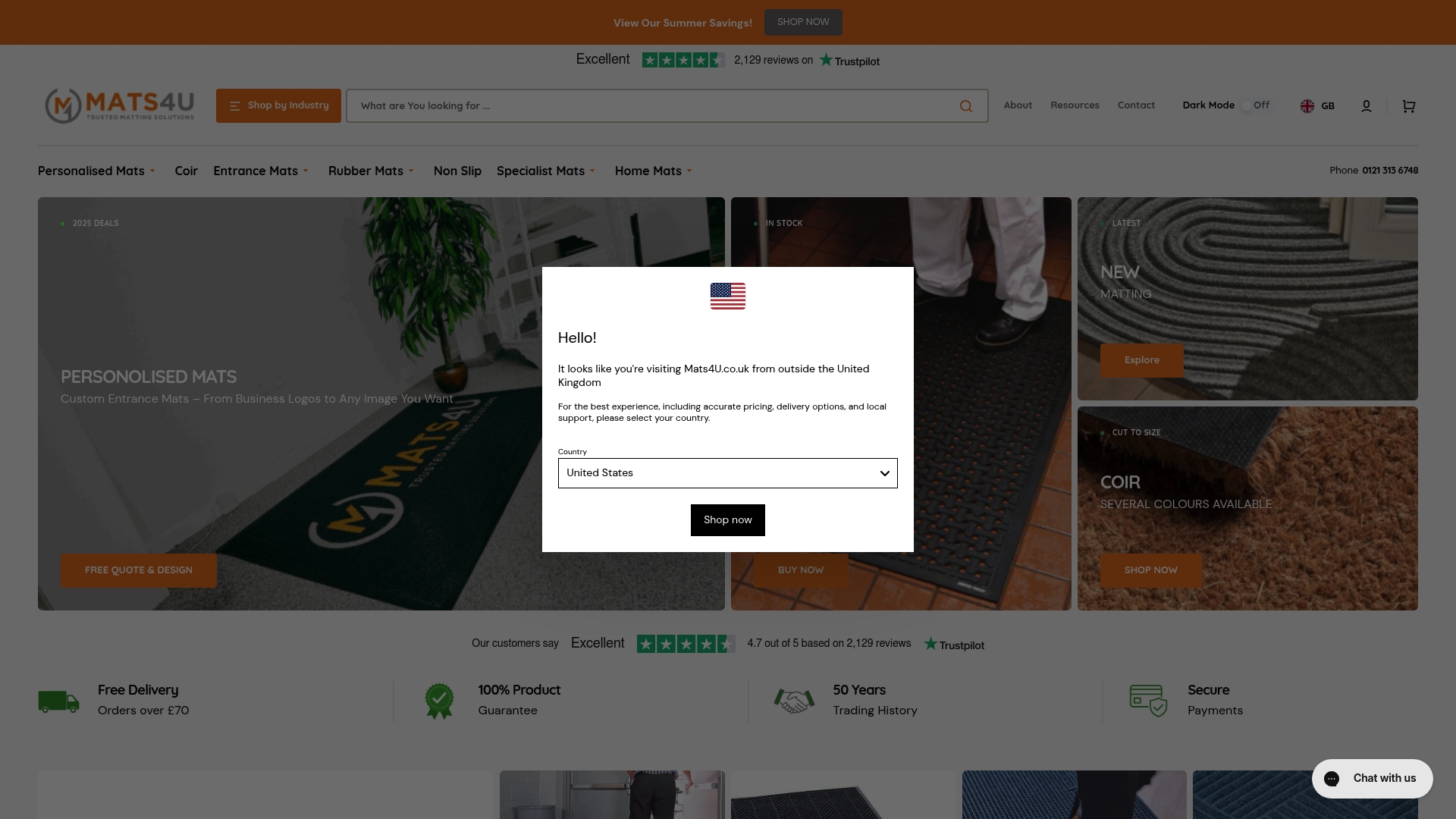Retail entrance matting sounds like a minor detail in a commercial setting and most would think it is just about keeping floors clean. But the numbers reveal a much bigger impact. A well-chosen mat can trap up to 80 percent of dirt and moisture before it even gets inside, slashing cleaning costs and reducing accidents. This is not just about stopping muddy footprints or catching rainwater. Smart entrance matting actually shapes your brand’s first impression and shows you care about both safety and professionalism.
Table of Contents
- Understand The Importance Of Entrance Matting
- Choose The Right Material For Your Needs
- Consider The Size And Shape Of Your Entrance
- Ensure Proper Slip Resistance Features
- Look For Easy Maintenance Options
- Custom Branding Possibilities For Matting
- Evaluate Cost Vs. Long-term Investment
Quick Summary
| Takeaway | Explanation |
|---|---|
| Invest in quality entrance matting | High-quality mats enhance safety, cleanliness, and aesthetic appeal while reducing long-term costs. |
| Select materials based on environment | Choose synthetic or natural fibres according to traffic, moisture levels, and durability needs of your space. |
| Utilise multiple mat zones | Implement a layering system of mats to effectively trap dirt, moisture, and enhance cleanliness. |
| Ensure slip resistance features | Incorporate mats with advanced slip-resistant materials and design to mitigate potential accidents. |
| Consider cost as a long-term investment | Evaluate total costs, including maintenance and safety benefits, when selecting entrance matting solutions. |
1: Understand the Importance of Entrance Matting
Retail entrance matting is far more than a simple decorative element. It serves as a critical first line of defence for your commercial space, protecting floors, reducing slip hazards, and creating a professional first impression. When properly selected, entrance mats work tirelessly to maintain cleanliness, safety, and aesthetic appeal.
For UK businesses, entrance matting plays a strategic role in managing environmental challenges. Britain’s unpredictable weather means moisture control becomes paramount. A high-quality entrance mat can capture up to 80% of dirt and moisture before it enters your premises, significantly reducing cleaning costs and minimising potential slip risks.
The primary functions of retail entrance matting include:
-
Moisture absorption: Preventing water and mud from spreading across floor surfaces
-
Dirt containment: Trapping particulates that could damage expensive flooring
-
Safety improvement: Reducing slip and fall incidents in high-traffic areas
-
Brand presentation: Creating a professional first visual impression for customers
According to Health and Safety Executive Guidelines, proper entrance matting is a fundamental strategy in preventing workplace accidents. By investing in robust retail entrance matting, businesses can demonstrate their commitment to safety and professionalism.
Commercial spaces ranging from shopping centres to office complexes understand that entrance matting is not an optional extra but a necessary investment. Our guide on why your fitted entrance mat is failing provides deeper insights into selecting the right matting solution for your specific environment.
Consider entrance matting as more than just a floor covering. It is a strategic tool that supports cleanliness, safety, and brand image while delivering measurable benefits in maintenance and risk management.
2: Choose the Right Material for Your Needs
Selecting the appropriate material for retail entrance matting is crucial in ensuring optimal performance, durability, and aesthetic appeal. Different environments demand specific material characteristics that can dramatically impact functionality and maintenance requirements.
Synthetic materials like polypropylene and nylon offer exceptional durability and moisture resistance, making them ideal for high-traffic commercial spaces. These materials can withstand substantial wear and provide consistent performance under challenging conditions.
Natural fibres such as coir and cotton present alternative options with unique advantages. Coir mats, derived from coconut husks, offer excellent scraping properties and natural water absorption, perfect for entryways prone to mud and debris.
Key considerations when evaluating entrance mat materials include:
-
Moisture absorption capacity: Different materials retain and release water at varying rates
-
Durability under foot traffic: Some materials deteriorate faster than others
-
Cleaning and maintenance requirements: Certain fabrics demand more frequent professional cleaning
-
Environmental resistance: Performance in humidity, temperature variations, and direct sunlight
According to BCFA Commercial Interior Design Guidelines, material selection should align with specific environmental conditions and anticipated usage patterns. Industrial settings might require heavy-duty rubber compounds, while retail spaces could benefit from more aesthetically pleasing woven synthetic options.
Understanding outdoor mats for wet areas provides additional insights into material performance under challenging conditions. Businesses must balance practical requirements with visual presentation, recognising that entrance matting serves both functional and branding purposes.
For UK commercial environments, where weather conditions can be unpredictable, selecting versatile materials that offer moisture management, durability, and aesthetic appeal becomes paramount. Professional consultation can help identify the most suitable entrance matting solution tailored to specific operational needs.
3: Consider the Size and Shape of Your Entrance
The dimensions and configuration of entrance matting are critical factors that directly impact its effectiveness in managing dirt, moisture, and foot traffic. Proper sizing ensures maximum debris containment and creates a seamless transition between exterior and interior environments.
Commercial entrances vary significantly across different UK retail and business settings. A one-size-fits-all approach simply does not work. Comprehensive entrance matting strategies typically involve multiple mat zones designed to capture and remove contaminants systematically.
Key entrance matting zone considerations include:
-
Scraper zone: External mat designed to remove larger debris and initial moisture
-
Wiper zone: Intermediate mat capturing finer particles and remaining moisture
-
Final cleaning zone: Interior mat completing the cleaning process
The recommended total mat length for effective dirt removal is approximately 1.5 metres, which allows sufficient steps to clean footwear thoroughly. This recommendation applies to most standard commercial and retail entrances, though specific requirements may vary based on traffic volume and environmental conditions.
According to Health and Safety Executive workplace guidance, entrance mat coverage should extend across the entire width of the doorway, with a minimum recommended depth that allows for multiple stepping actions.
Shape considerations extend beyond rectangular configurations. Curved entrances, revolving doors, and irregular architectural layouts demand custom matting solutions. Modern entrance matting can be tailored to fit complex spatial requirements, ensuring comprehensive coverage without compromising aesthetic appeal.
Our commercial mat cleaning guide offers additional insights into maintaining mat effectiveness across different entrance configurations. Professional measurement and consultation remain essential in developing a truly optimised entrance matting strategy that balances functional performance with visual integration.
4: Ensure Proper Slip Resistance Features
Slip resistance is a critical safety consideration for retail entrance matting, particularly in high-traffic commercial environments across the United Kingdom. Preventing potential accidents requires strategic selection of materials and design features that minimise slip risks.
Modern entrance mats incorporate advanced slip-resistant technologies that go beyond traditional surface treatments. These innovations include specialised backing materials, textured surfaces, and precision engineering designed to enhance traction under various environmental conditions.
Key slip resistance features to evaluate include:
-
Surface texture: Raised patterns and micro-grooves that channel water and improve grip
-
Backing composition: Non-slip rubber or silicone compounds that prevent mat movement
-
Edge design: Bevelled edges reducing tripping hazards and ensuring smooth transitions
According to Health and Safety Executive workplace guidance, slip-related incidents account for a significant proportion of workplace accidents. This underscores the importance of selecting entrance mats with robust slip resistance capabilities.
Learn how to prevent mat slipping on different surfaces to understand the nuanced approaches required for different flooring types.
British commercial spaces must consider additional factors such as moisture levels, foot traffic intensity, and specific environmental challenges. Professional-grade entrance mats often feature multiple slip resistance technologies, including:
-
Advanced drainage channels
-
Multi-directional grip patterns
-
Resilient materials that maintain performance under continuous use
Beyond safety, proper slip resistance contributes to maintaining a professional image and demonstrating organizational commitment to employee and customer well-being. Businesses should view entrance matting as a strategic investment in risk management and workplace safety.
5: Look for Easy Maintenance Options
Maintaining retail entrance matting is crucial for preserving its functionality, appearance, and longevity. Selecting mats with straightforward cleaning requirements can significantly reduce operational costs and ensure consistent performance across commercial environments.
Modern entrance matting technologies have evolved to incorporate materials and designs that simplify maintenance processes. Synthetic fibres, advanced backing materials, and innovative weaving techniques now enable mats to resist dirt accumulation, moisture retention, and rapid deterioration.
Key maintenance considerations for entrance mats include:
-
Washability: Ability to withstand regular cleaning without structural degradation
-
Quick-drying properties: Preventing moisture retention and potential bacterial growth
-
Lightweight design: Enabling easy lifting and thorough cleaning
-
Stain resistance: Materials that repel dirt and maintain aesthetic appearance
According to British Cleaning Council guidelines, regular maintenance is essential for preserving mat effectiveness and workplace hygiene standards. Professional-grade entrance mats should facilitate efficient cleaning protocols without requiring extensive labour or specialised equipment.
Our comprehensive commercial mat cleaning guide offers detailed insights into maintaining entrance matting across various commercial settings.
British businesses must consider maintenance frequency, cleaning methods, and long-term durability when selecting entrance mats. Modular mat systems provide additional flexibility, allowing individual sections to be replaced or cleaned without compromising the entire installation.
Advanced entrance mats now incorporate antimicrobial treatments and resist colour fading, ensuring they remain functional and visually appealing with minimal intervention. By prioritising easy maintenance, organisations can reduce long-term costs, maintain professional appearances, and create safer, cleaner entrance environments.
6: Custom Branding Possibilities for Matting
Custom branded entrance matting offers UK businesses a powerful marketing tool that seamlessly combines functionality with visual communication. Strategic mat branding transforms entrance areas from mere functional spaces into dynamic brand touchpoints that engage customers from the moment they arrive.
Modern printing technologies enable unprecedented levels of customisation, allowing organisations to incorporate logos, colour schemes, and messaging directly into entrance mat designs. These branded solutions provide multiple strategic advantages beyond traditional marketing approaches.
Key branding opportunities through entrance matting include:
-
Corporate logo integration: Precise digital printing techniques
-
Colour matching: Alignment with precise corporate brand guidelines
-
Messaging placement: Incorporating taglines or welcome messages
-
Seasonal design variations: Updating mat designs for different campaigns
According to British Promotional Merchandise Association research, branded entrance mats represent a cost-effective marketing medium with high visibility and prolonged customer engagement.
Maximise your brand visibility with branded mats provides comprehensive insights into leveraging entrance matting as a strategic branding tool.
Innovative businesses can now select from multiple customisation options, including full-colour digital printing, embroidered designs, and multilayered mat configurations that maintain both aesthetic appeal and functional performance. These solutions transform entrance areas into powerful brand communication platforms.
Custom branded mats serve multiple purposes: they welcome visitors, reinforce brand identity, communicate organisational professionalism, and create memorable first impressions. By treating entrance matting as a strategic branding asset, UK businesses can differentiate themselves in competitive commercial environments.
7: Evaluate Cost vs. Long-term Investment
Choosing retail entrance matting requires a strategic approach that balances immediate financial considerations with long-term operational benefits. Intelligent investment in quality matting can generate substantial savings and value across multiple business dimensions.
While initial purchase price represents an important factor, savvy UK businesses must consider comprehensive cost implications beyond the initial outlay. Entrance mats are not merely passive floor coverings but active investments in safety, brand presentation, and facility maintenance.
Key financial considerations include:
-
Durability: Higher quality mats reduce replacement frequency
-
Maintenance costs: Superior materials minimise cleaning and replacement expenses
-
Potential accident reduction: Preventing slip hazards can mitigate potential insurance claims
-
Brand perception: Professional matting contributes to overall business image
According to British Retail Consortium risk management guidelines, proactive investment in quality entrance solutions can significantly reduce potential workplace incidents and associated financial risks.
Understanding made-to-measure mat solutions provides deeper insights into selecting cost-effective matting strategies.
British commercial environments should calculate total cost of ownership, considering factors beyond initial purchase price. Professional-grade entrance mats typically offer superior performance metrics, including:
-
Extended operational lifespan
-
Reduced floor maintenance expenses
-
Enhanced safety compliance
-
Improved aesthetic presentation
Ultimately, entrance matting represents a strategic investment in organisational professionalism. By prioritising quality, businesses can transform a seemingly simple floor covering into a multifunctional asset that delivers tangible financial and operational benefits across their commercial environment.
Below is a comprehensive table summarising the key decisions, considerations, and benefits of choosing retail entrance matting, as detailed in the article.
| Aspect | Key Information & Recommendations |
|---|---|
| Importance of Entrance Matting | Essential for dirt and moisture control, enhances safety, lowers cleaning costs, and delivers a strong first impression. |
| Material Selection | Choose synthetic (polypropylene, nylon) for durability and moisture; use natural fibres (coir, cotton) for scraping/absorption. |
| Size and Shape | Tailor mat to entrance width and expected footfall; employ multiple zones (scraper, wiper, cleaning) for optimal performance. |
| Slip Resistance | Select mats with textured surfaces, non-slip backing, and bevelled edges; supports accident risk reduction and compliance. |
| Maintenance | Opt for mats that are washable, quick-drying, stain-resistant, and easy to handle; modular mats allow easier upkeep. |
| Custom Branding | Integrate logos, colours, messages using modern printing for strong brand presence; supports marketing and customer engagement. |
| Cost vs. Long-term Investment | Consider total ownership costs, durability, safety savings, and branding impact rather than only initial expense. |
Transform Your Retail Entrance with the Right Matting Solution
Are you struggling to keep your retail space clean, safe, and welcoming with changing UK weather and heavy footfall? The article has shown that choosing the proper retail entrance matting means more than picking a generic mat. It is about preventing dirt and moisture from invading your store, reducing cleaning expenses, and creating a professional first impression. Yet, finding matting that balances durability, easy maintenance, and strong branding is a challenge.
Explore our Retail Industry Mats collection, where you will discover custom options made for the demands of high-traffic entrances. You can safeguard your floors, protect your customers, and make a positive first impression—without extra effort.

Ready to make cleaning simpler, improve floor safety, and reinforce your brand? Visit our main site or browse custom retail matting solutions designed for UK businesses. Act today and give your store the protection and visual appeal it deserves.
Frequently Asked Questions
What are the main benefits of retail entrance matting?
Retail entrance matting provides moisture absorption, dirt containment, safety improvement, and a professional brand presentation. It helps protect your floors, reduces slip hazards, and maintains a clean environment.
How do I choose the right material for my entrance mat?
Selecting the right material involves considering moisture absorption capacity, durability under foot traffic, cleaning requirements, and environmental resistance. Synthetic materials like polypropylene are ideal for high traffic, while natural fibres like coir offer excellent scraping properties.
What size entrance mat do I need for my commercial space?
The recommended total mat length for effective dirt removal is approximately 1.5 metres. Ensure the mat covers the entire width of the doorway and consider multiple mat zones for optimal functionality, including scraper, wiper, and final cleaning zones.
How can I ensure my entrance mat has effective slip resistance?
To ensure slip resistance, look for mats with textured surfaces, non-slip backing, and bevelled edges. Advanced mats may also incorporate drainage channels and multi-directional grip patterns to enhance traction and minimise slip risks.









